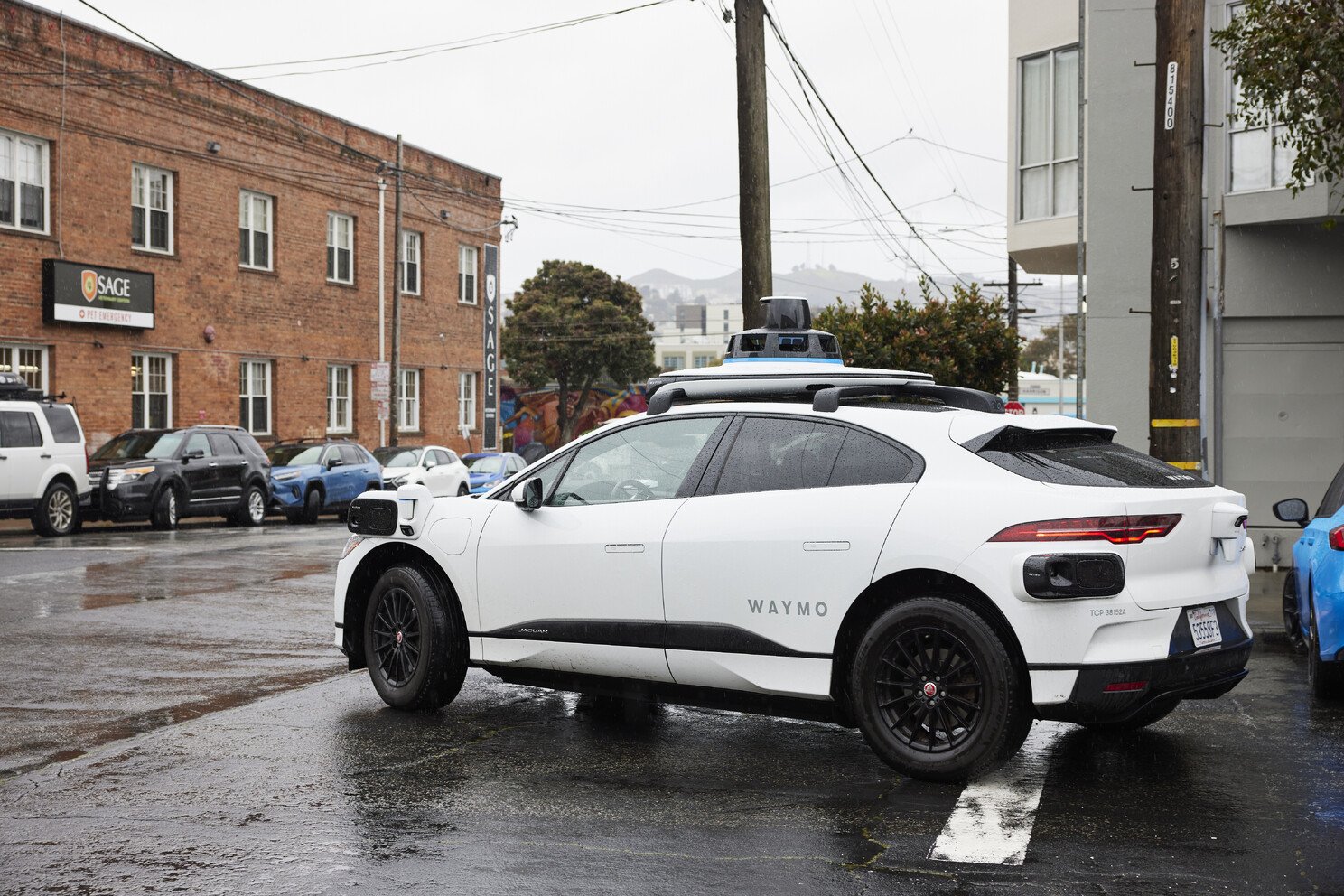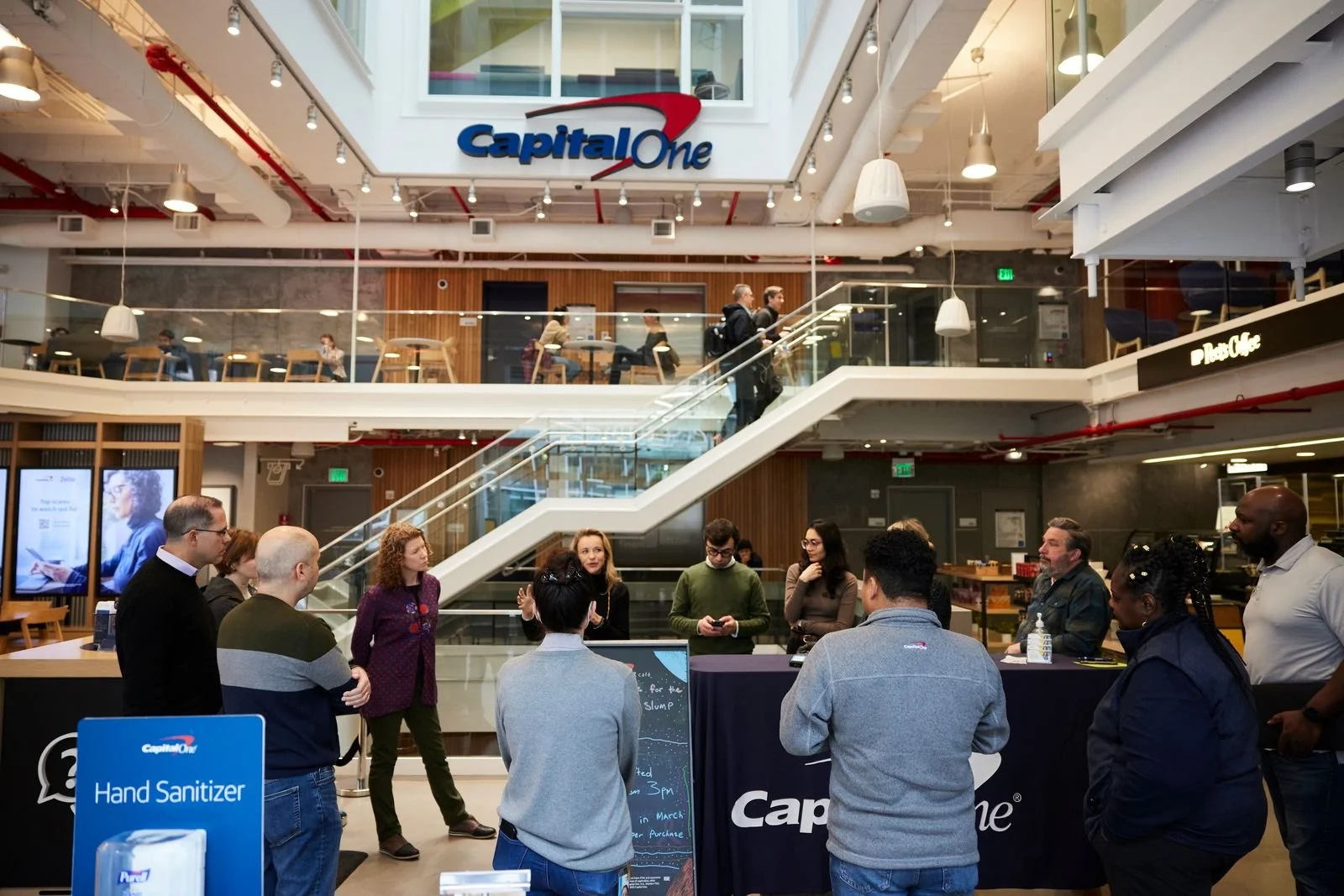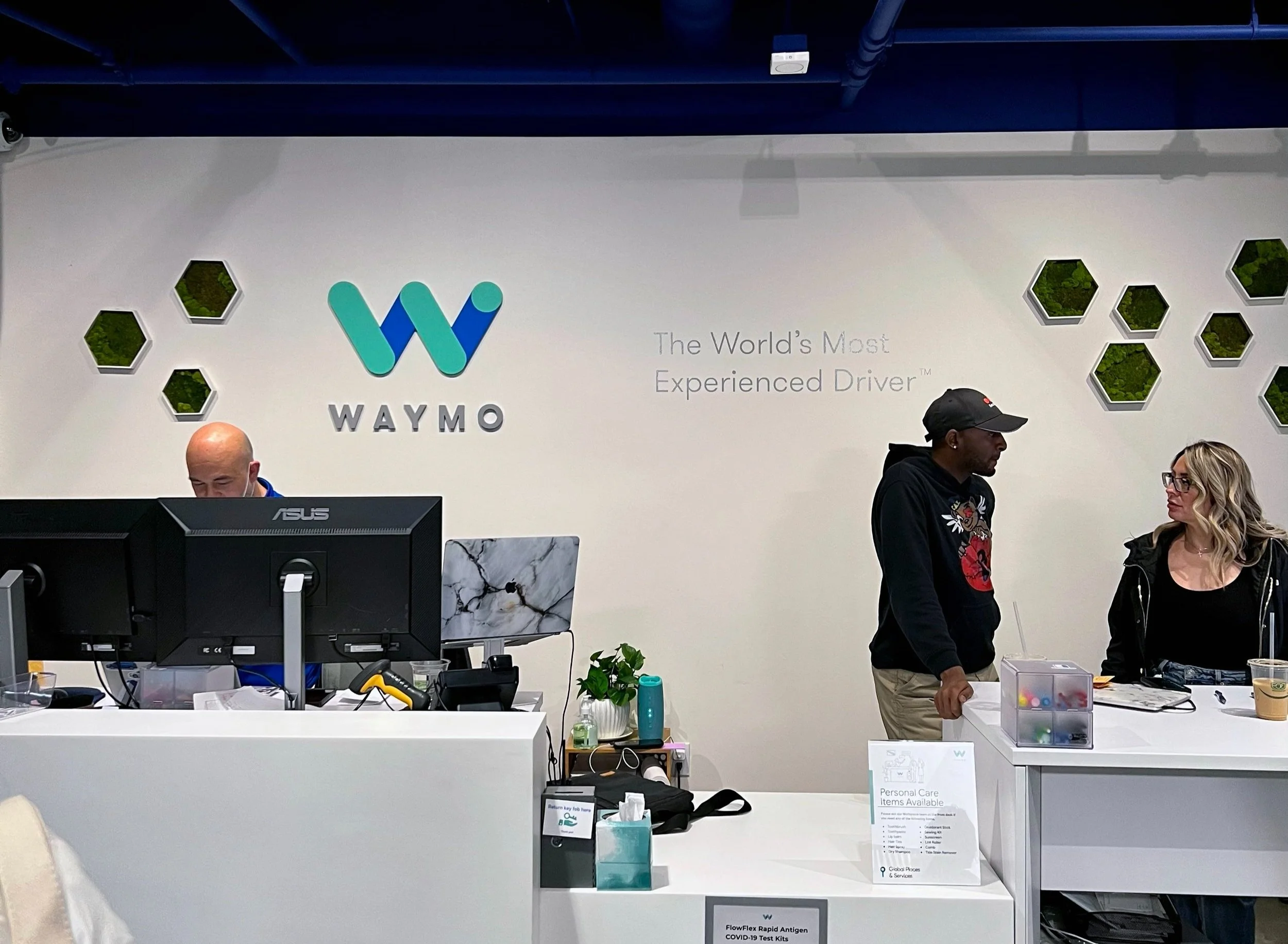
The Authoring Team in San Francisco. Photo by Murmur Ring/Dylan Chandler
June 08, 2023
When Every Big Company
is a Tech Company
A design immersion in San Francisco, California
Published on
LinkedIn
Edited & Hosted by
Ashley Lukasik
Murmur Ring
On March 9th, 2023, we brought together nine design leaders working across a variety of industries and research focus areas in San Francisco for a single day immersion exploring everyday infrastructures. Composed of experiential site visits with local partners in the mobility, financial, technology, and urban planning sectors, this single-day immersion sought to investigate, advance, and amplify the research work being conducted by Carlos Teixeira, Deaa Bataineh, and Jessica Meharry at the Institute of Design (ID) at Illinois Institute of Technology to expand the notions of how infrastructures are defined; how they adapt to emerging technology, the changing needs of society, and the merging of public and private investment. Our key areas of interest were the move toward a cashless society and automation in mobility. The immersion will serve as an input for ongoing research being conducted by Carlos’ current and former PhD researchers. These include the exploration of asymmetries of power in the technology sector and in the development of digital products, and infrastructure-platform mashups and its implications for strategic choice-making©.
Site visit 1:
Breakfast and observation at Capital One Café with the Experience Design team
Capital One is reimagining banking with the Capital One Café. The idea is simple: Create a welcoming space where banking meets living. Where everyone can relax, refuel, and unwind, whether they're Capital One customers or not. Together—Cafés and our Café teams—play a unique role in our local communities, one that runs deeper than customer finances.
Immersion Partner:
Miguel Lunaparra, Sr. Director, Experience Design at Capital One
Site visit 2:
Conversation with Waymo’s UX Research and Design team and ride in self-driving vehicles
Waymo's mission is to make it safe and easy for people and things to get where they're going. From moving people to moving goods, we're taking autonomous driving to new places. Our mission is big and our work has the potential to transform lives.
Immersion Partner:
Ryan Powell, UX Research & Design Team Lead at Waymo
Site visit 3:
Neighborhood walk exploring shared and mixed-use spaces with Livable City
Livable City works to create a San Francisco of great streets and complete neighborhoods, where walking, bicycling, and transit are the best choices for most trips, where public spaces are beautiful, well-designed, and well-maintained, and where housing is more plentiful and more affordable.
Immersion Partner:
Tom Radulovich, Executive Director of Livable City
Here, we reflect on new inputs gained from this experience that inform the research we are conducting at the Institute of Design (ID) at Illinois Institute of Technology.
Carlos: How do you analyze the everyday infrastructures that we saw in San Francisco?Deaa: This was my first visit to San Francisco. It is a beautiful city and I left fascinated by the innovations taking place there. I noticed that each institution's innovation efforts require collaboration on a larger scale beyond their own boundaries. Waymo faces the challenge of navigating city policies while implementing its own system. Livable City has also encountered complexity in its discussions on parklets and parking meters.
Multiple stakeholders are involved in developing “mashup” spaces. These “mashups” combine public infrastructures and private platforms. One striking observation is that these stakeholders often find themselves confined within their own organizations when it comes to innovation. They recognize this limitation and strive to break free, but lack the necessary know-how to bring all stakeholders together for collective collaboration.
Parking meters and cashless payments in San Francisco. Right photo by Carlos Teixeira, left photo 2 by Deaa Bataineh.
Carlos: One topic we focused on was mobility, like the driverless rides with Waymo and the parking solutions that we discussed with Tom of Livable City. How do you think these examples relate to your research?
Jessica: The driverless ride was the moment when the interaction that we had was most about designing for a user. The ways in which Ryan [Powell] talked about how to communicate trust, how to let the user know what was happening, had me considering the asymmetries of knowledge and information. There's so much to consider as far as what information is important for the rider to know and not know in order to trust that experience, and feel like they still have control over it. I think there's a lot of interesting and challenging questions there.
The autonomous vehicle (Waymo), Video by Deaa Bataineh
Jessica: With things like asset parking and dynamic pricing, the idea of asymmetries and inequitable impacts is much further down the line. There's not really a consideration of whether someone can afford to park somewhere or not. It's about limiting parking to a neighborhood for density control. It doesn't help someone with a lower income to park. But if you're limiting parking, you might use those resources to build public transit. You're trying to shift relationships to a different location. So, you're really just focusing on users who have the ability to use a car, with the intended impact elsewhere.
Carlos: Can you break down how you define everyday infrastructures such as the driverless ride and parking meters in terms of algorithmic materiality?
Jessica: I would answer that by saying that algorithmic materiality is present in all of those things, but considered at different levels, and in different quantities. In some cases, the impacts were understood more clearly. Obviously, Waymo/Google has deep knowledge of what it is and isn’t doing, versus initiatives happening at the other local city level. Maybe that connects back to what Deaa’s says about people being trapped inside their own organizations. This came up in our conversations, that the people with the most knowledge about how all these things fit together aren't participating in the design of it.
Carlos: I want you to explore a different territory: cashless society. Two infrastructures that caught my attention in San Francisco were money coaching and embedded finance. Money coaching is about helping people transition between analog and digital, virtual spaces in finance, and also knowing how to manage money. But there was also something that we hadn’t anticipated: embedded finance. A lot of payments, insurance, etc. are being fully embedded into products and services that are somewhat invisible to the people using them.
Banking as embedded finance. Photo by Carlos Teixeira
Deaa: We can examine money coaching and embedded finance from both a human-centric and user-centric perspective. However, it's crucial to also think about these everyday infrastructures at the nexus of multiple systems on multiple levels. These infrastructures have wide-ranging impacts—human, societal, and economic. This raises the question of responsibility: Who should bear the responsibility for these impacts?
At Capital One, there is a reevaluation of finance coaching within the organization, emphasizing a human-centric approach. They are focused on driving increased customer interaction with their brand. This shift highlights the importance of prioritizing the human experience.
Collaboration among stakeholders depends on identifying who is responsible for bringing them together. Tom's [of Livable City] perspective while observing embedded finance in the parking lot and dynamic parking meter pricing prompts the question of whether it is the responsibility of a sustainable public space advocate like Tom, a bank like Capital One or NuBank, or public infrastructure, and the government.
In this case, public infrastructure or the government may hold the responsibility for bringing all stakeholders together. Cities can be seen as the everyday infrastructure. Like dynamic pricing, we might envision dynamic cities or neighborhoods where the management of such spaces becomes a critical consideration. We would consider: Who establishes the rules? Should it be an imposed everyday infrastructure or a collaborative process? Alternatively, should city-level governments take charge of setting plans with rules that people adhere to?
Many countries and cities are yet to establish clear rules for utilizing these emerging everyday infrastructures. These new artifacts merge algorithmic and materiality aspects, setting new rules for public and private interactions. Paying for parking, for instance, involves factors that extend beyond mere financial transactions enabled through data.
Carlos: Considering these new artifacts as data-driven products, what are your reflections on a cashless society, money coaching, and embedded finance?
Jessica: The first thing that runs through my head is, What kind of data? That's the thing with algorithmic materiality–even before the algorithm, what's the data? What kind of data are we getting? That's central. Then, who is the design team? What do they know about what they're working with?
Driverless rides as algorithmic materiality. Photo by Murmur Ring/Dylan Chandler
Jessica: Deaa, you mentioned dynamic cities or neighborhoods. That made me think back to Ryan's presentation. He repositioned how Waymo was designed as city-centered instead of human-centered. The city is the central thing around which they're designing. We also talked about cities being conductors and orchestrators, rather than providers. When we think conceptually new methods or methodologies this might generate, it also surfaces the limitations of human centered design.
Part of what Capital One does is center trust as part of their business model. With regard to collaboration, once you start connecting stakeholders, how do you center trust? do you maintain it when all the different players have different agendas?
Embedded finance and the multistakeholder economy. Photo by Murmur Ring/Dylan Chandler
Carlos: One thing that I want to highlight is the notion of disputed, contested territory. As you said, everybody's in the same ecosystem, yet everybody's still looking from their own point of view. So, every single space is highly contested.
Deaa: I consider mashups at two levels: platforms and infrastructures: How can we effectively integrate existing infrastructures into platforms? Transportation serves as a prime example.
The Platformization of transportation has disrupted traditional infrastructure and regulatory models governing roads, signage, public transportation, buses, taxis, and more. This disruption is ongoing, with further advancements in technology yet to unfold. As we delve into the realm of materiality and algorithms, it becomes apparent that algorithms have not caught up with the material aspects. This presents a challenge: how do we regulate emerging transportation platforms while harnessing their convenience and accessibility?
Driverless rides and the multistakeholder economy. Photo by Deaa Bataineh
Deaa: Waymo, for instance, which aims to be the safest driver. That’s amazing. However, cities also strive to alleviate congestion during peak traffic hours. So, how can we leverage driverless cars to address congestion effectively? Moreover, how can we ensure sustainability and reduce emissions in the process?
These are complex issues that necessitate thoughtful exploration and innovative solutions, collaboratively with multiple stakeholders involved at the intersection of technology, regulations, and environmental considerations. By addressing them, we can shape transportation systems that are safe, efficient, and environmentally friendly.
Carlos: Jessica, I love your comment about the limitations of human-centered design when it comes to dealing with multiple stakeholders, both human and nonhuman. In San Francisco, it struck me that everybody talks as a maker, not as a thinker. I didn't see much leverage or much currency in “design thinking,” because everybody had a mindset of making something to serve as a proof-of-concept. And it's also not about agile anymore - it's about making it as a proof of concept, rather than thinking.
Jessica: I don't know why I didn't consider it before, but it was really interesting that Capital One was using the built environment to create a behavior change around a digital activity. There was this constant play between the digital and physical that we saw in every example.
Driverless rides as Algorithmic Materiality. Video by Deaa Bataineh
Jessica: It’s very difficult to predict what will happen when working with algorithms materially. The fact that I couldn't really even fully understand the self-driving car until I sat in it shows how much technology is changing our lives and the way we interact, and things beyond our ability to imagine it. So, if you think about what designers could contribute is futuring and scenario building to actually understand potential ramifications versus an attitude of “just do it and see what happens later,” which always puts us in a position of being reactionary.
Deaa: The notion of "maker versus thinker" resonates with me. A few key considerations: First, there's a culture in Silicon Valley that extends to the broader realms of technology and innovation. It embodies the mindset of "it's easier to ask for forgiveness than permission," to foster a proactive and entrepreneurial spirit. Second, conducting research through design, whereby creating something provides a means of gaining insights and reflecting upon it in a closed loop to allow for continuous refinement and improvement.
Carlos: Who drives change? Or more importantly, who defines where to play and how to win in the disputed territories of everything infrastructure?
Deaa: When creating the final product, it becomes evident that product managers are responsible for decision-making, UX designers handle choice-making, and engineers work on implementing solutions.
The ones driving innovation are the ones who determine the playing field. The first to present a solution holds the control. However, winning is a journey that requires strategic navigation. In the realm of driverless cars, several companies are in the race, and the first to succeed can assert, "This is what we have." Of the three roles: decision making, choice making, solution making, the designer will be best equipped to articulate the where to play space. However, determining the direction of how-to-win can happen through the technology, the need, or maybe a crisis that unveils our needs.
Carlos: These days, every company is a tech company. We used to talk about the “big tech companies”, but even though Capital One doesn’t come from tech at its root, it is now a tech company. Every big company has a strong strategy that embeds tech in the everyday life of people in all aspects. This is creating the algorithmic materiality out of every single human and non-human activity. And they are data-driven products and services being created by the triage of decision makers, choice makers, and solution makers. With every company trying to dispute and play in that space, and all products entering disputed territories, this is a moment when we realize the importance of understanding the consequences of embedding algorithmic materiality into everyday life.
ABOUT THE AUTHORS:
Deaa Bataineh is a designer, researcher, and consultant specializing in innovation at the intersection of systems, design, and strategy. He holds a PhD from the Institute of Design (ID) at Illinois Institute of Technology, where he developed the Strategic Choice-Making© model. His work addresses complex infrastructures—such as EV charging, emergency response, and digital payments—as platforms for equitable and sustainable transformation. He serves on the Aux Board of the Design Museum of Chicago, co-founded the design department at Jordan University of Science and Technology in Jordan, and hosts the podcast espresso?. For more visit Deaa’s website here.
Carlos Teixeira is a designer, professor, and consultant with over 20 years of experience working at the intersection of design strategy, open innovation, and systemic transformation. He is the Charles L. Owen Professor in Design and Director of the PhD Program at the Institute of Design (ID), Illinois Institute of Technology, where he leads research and teaching on infrastructure design, innovation platforms, and global collaboration. A native of Brazil, Carlos previously served as Associate Professor at Parsons School of Design - The New School in NYC and is known for co-creating the DREAM:IN Project, recognized by Metropolis Magazine as a 2013 Game Changer. To learn more about Carlos’s work, visit this website, here.
Jessica Meharry is a designer, researcher, facilitator, and educator focused on justice-oriented design methodologies in practice. She is currently a tenured professor at Loyola University. Previously, she was a visiting professor at the Institute of Design (ID), Illinois Institute of Technology, where she teaches graduate courses on equitable and liberatory design. She was also an Associate Professor of Design Management and Director of Academic Diversity, Equity, and Inclusion at Columbia College Chicago. Jessica earned her PhD in Design from the Institute of Design in 2022, with a dissertation titled Sensemaking for Power Asymmetries in Anti-Oppressive Design Practice, advised by Carlos Teixeira and Laura Forlano. Her research explores anti-oppressive design practices, envisioning anti-racist futures, and equity-centered experiential education. She also maintains an award-winning creative practice in graphic design for personal explorations and professional clients.
Partners:
Miguel Lunaparra, Sr. Director, Experience Design at Capital One
Ryan Powell, UX Research & Design Team Lead at Waymo
Tom Radulovich, Executive Director of Livable City
Galen Cranz, Professor of the Graduate School, Architecture at the College of Environmental Design at the University of California, Berkeley
Participants
Ellen Kiss, Director of Design Center of Excellence, NUBANK
Lauren Braun, Product Manager at Apple Watch + Health
Mrinali Gokani, Sr. Specialist/ Strategy at Samsung Research America (SRA)
Michael Dila, Design & Innovation Leader







